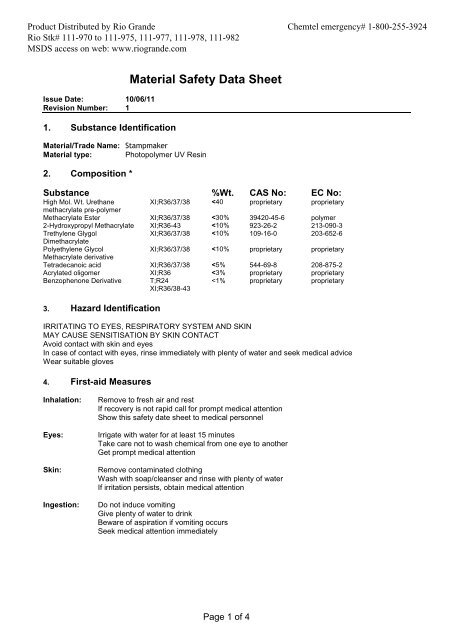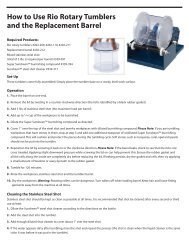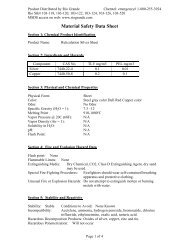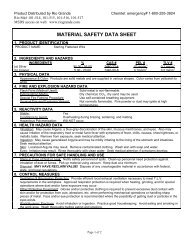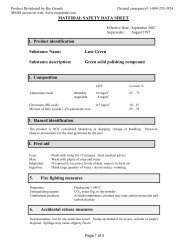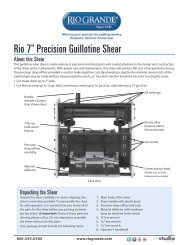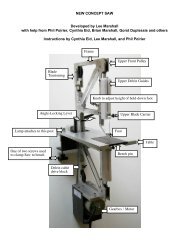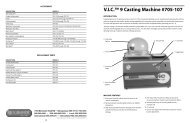Imagepac Stampmaker MSDS - Rio Grande
Imagepac Stampmaker MSDS - Rio Grande
Imagepac Stampmaker MSDS - Rio Grande
You also want an ePaper? Increase the reach of your titles
YUMPU automatically turns print PDFs into web optimized ePapers that Google loves.
Product Distributed by <strong>Rio</strong> <strong>Grande</strong> Chemtel emergency# 1-800-255-3924<strong>Rio</strong> Stk# 111-970 to 111-975, 111-977, 111-978, 111-982<strong>MSDS</strong> access on web: www.riogrande.comIssue Date: 10/06/11Revision Number: 11. Substance IdentificationMaterial Safety Data SheetMaterial/Trade Name: <strong>Stampmaker</strong>Material type: Photopolymer UV Resin2. Composition *Substance %Wt. CAS No: EC No:High Mol. Wt. UrethaneXI;R36/37/38
5. Fire-fighting MeasuresSuitable Extinguishers:Unsuitable Extinguishers:Hazardous Decomposition:Special Procedures:Alcohol resistant foamDry powderCarbon dioxideWater fog/sprayDirect water jetsToxic fumes are produced in fireDo note breathe decomposition products and fumesUse approved self-contained breathing apparatusWear fire retardant clothingWear eye protectionUse water spray to cool containersPrevent runoff from fire control from entering waterwaysLarge fires should only be dealt with by trained personnel6. Accidental Release MeasuresExposure Controls:Personal Protection:Disposal Considerations:Ventilate areaIsolate the spillageUse barriers to prevent accidental entry into contaminated areasDo not allow spill to enter drains and watercoursesWear suitable respiratory protection e.g. EN405 FFA2 or EN140 A2Wear polythene glovesUse eye protection such as goggles to BS EN 166 Chemical GradeAbsorb in inert material such as sand or absorbent granulesScoop up and place in plastic container to await transferSpill is classed as special waste7. Handling and StorageHandling:Storage:Avoid skin and eye contactAvoid inhalation of vapourEnsure adequate ventilationUse local extraction equipment where possibleWear suitable protective clothing (see section 8)Store in tightly closed labelled containersStore in a cool, dry well ventilated area8. Exposure ControlsOccupational Exposure Limited:Not AssignedWear polythene glovesWear suitable overalls or apron and change if contaminatedWear suitable eye protection such as BS EN 166Use in well ventilated areasUse mechanical ventilation if possibleIf excessive inhalation in a poorly ventilated area is likely then use arespirator with filter type AAfter contact with skin wash off immediatelyPage 2 of 4
9. Physical & Chemical PropertiesAppearance: Various coloured viscous liquidsOdour: CharacteristicPH: n/eBoiling point/range : n/eMelting point/range : n/eFlash point: >65C (Closed Cup)Flammability : NON-FLAMMABLEAutoflammability : n/eExplosive properties : noneOxidising properties : noneVapour pressure : n/eRelative density : n/eSolubility: n/eVapour Density : n/eViscoslty: 30,000 cPsEvaporation rate : n/e(Bu Ac = 1)(n/e = not established)10. Stability and ReactivityStable at normal temperaturesMaterials to avoid: oxidising agentsConditions to avoid: high temperature, sources of ignition anddirect sunlightNo hazardous decomposition products when stored and handledcorrectly11. Toxicological InformationRoutes of exposure: inhalation, skin absorption and ingestionAcute effects: Profuse eye watering. Irritation of the respiratory tract andIrritation and redness at the site of skin contactRepeated skin contact may cause sensitisationChronic effects: Kidney and liver damage12. Ecological InformationEcotoxicity – Expected to be harmful to aquatic lifePersistence: No specific informationBioaccumulative potential: No specific informationMobility: No specific Information13. Disposal ConsiderationsDo not discharge into drains or watercoursesDispose through property licensed contractorsDispose of in accordance with the Special Waste Regulations 1996Page 3 of 4
14. Transport Information15. Regulatory InformationNot classified as hazardous for transporta) Risk & SafetyR36/37/38R43IRRITATING TO EYES, RESPIRATORY SYSTEM AND SKINMAY CAUSE SENSITISATION BY SKIN CONTACTS24/25 Avoid contact with skin and eyesS26In case of contact with eyes, rinse immediately with plenty of water and seekmedical adviceS37Wear suitable glovesb) Other RegulationsHealth & Safety at Work etc. Act 1974Control of Substances Hazardous to Health Regulations 1994Environment Protection Act 1990Special Waste Regulations 1996This Safety Data Sheet is compiled with reference to The Chemical (Hazard Information and Packaging forSupply) Regulations 2000 (CHIP3), which implement the Council Directives 67/548/EEC (The DangerousSubstances Directive) and 88/379/EEC (The Dangerous Preparations Directive), and subsequent amendingregulations, up to end including The Chemical (Hazard Information and Packaging for Supply) Regulations2000 (CHIP2000), which implements the 26 th ATP of 67/548EEC."The information herein is given in good faith, but no warranty, express or implied, is made."Page 4 of 4


